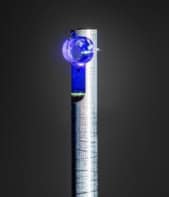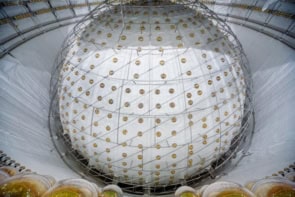Researchers in Canada have proposed a new way to make key medical isotopes that avoids the need for nuclear reactors and weapons-grade uranium.
The alternative technique uses a particle accelerator and could help secure a long-term, reliable supply of technetium-99m, which is a radioisotope that is used in around 80% of all diagnostic nuclear medicine tests worldwide.
Technetium-99m is a metastable nuclear isomer, that decays (with a half life of about six hours) to the much longer lived technetium-99 by emitting a gamma ray. It can be bound into a variety of special molecules that target specific parts of the body when ingested or injected. It’s location within the body can then be pinpointed by detecting the gamma rays.
Technetium-99m is created during the natural decay of the molybdenum-99. Nearly all of the global supply of molybdenum-99 is produced at just five nuclear reactors in a process that involves neutron-induced fission of enriched uranium-235 targets. Most of these sites rely heavily — or even exclusively — on weapons-grade enriched uranium.
Preventing future shortages
Concern is now mounting about the age, safety and reliability of these reactor operations following a series of well publicized technical problems and unscheduled plant shutdowns. New reactors are urgently needed to prevent future shortages of molybdenum-99, and hence technetium-99m. But gaining consent, funding and political support for such plans is proving to be far from easy.
So why not abandon the reactor-based approach altogether? A report released by the TRIUMF accelerator lab, the University of British Columbia, and the firm Advanced Applied Physics Solutions (AAPS), suggests that a reactor may not be needed.
The molybdenum-99 manufacturing method outlined in the report replaces the neutrons in the fission process with a highly intense photon beam, which is generated by an electron accelerator. The enriched uranium-235 target is also replaced by natural uranium (mostly uranium-238).
Much lower yield
This photofission process produces almost exactly the same fraction of molybdenum-99 as the neutron-induced fission of uranium-235 does. However, the probability of the uranium nucleus splitting is much, much lower. “All things being equal, you would need about 3000 photons for every neutron to get the same yield,” said Nigel Lockyer, Director of TRIUMF.
Up until now, this factor has prevented cyclotron accelerators such as the one at TRIUMF from being seen as a viable way of making molybdenum-99 — although the technology is applied to make many other medical isotopes.
Achieving a high yield of molybdenum-99 from uranium-238 photofission will require an extremely high-powered particle accelerator, and that’s exactly what researchers at TRIUMF hope to build. “Our nuclear medicine people have been used to working with micro-amps of beam current. I’m talking about using about 100 milliamps,” Lockyer said.
Less energy efficient
Researchers accept that an accelerator-based molybdenum-99 production facility would require substantially more electrical power to run than a reactor-based facility. However, the proposed set-up has many advantages compared with existing methods of commercial molybdenum-99 production. It will be possible to halt and re-start isotope production according to demand, something that can’t be achieved with a nuclear reactor.
The natural uranium targets will also be easier to handle, transport and dispose of than highly-enriched uranium. Low-enriched uranium is being phased in at some reactors used for isotope production, but the large-scale commercial supply of molybdenum-99 from these targets has yet to be established.
The next stage is to build a demonstration machine that can be used to validate the proposed system, Lockyer says. Construction is scheduled to start in 2010 with a view to commencing tests in 2013.
One important unknown is whether the multi-watt photon accelerator will literally be too hot to handle. Finding a way to remove the heat generated from the uranium target will be a “critical technical challenge,” according to Lockyer. The solution may be to scan the photon beam across multiple mini-targets. “You reduce the problem by the number of small targets that you have. We think this is something we can do,” he said.



